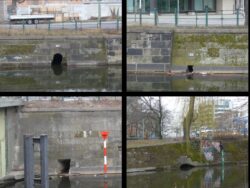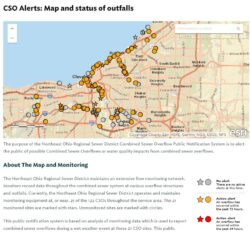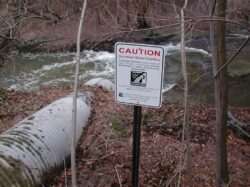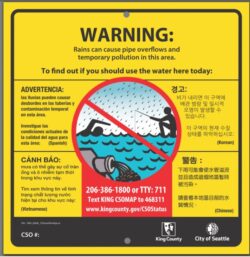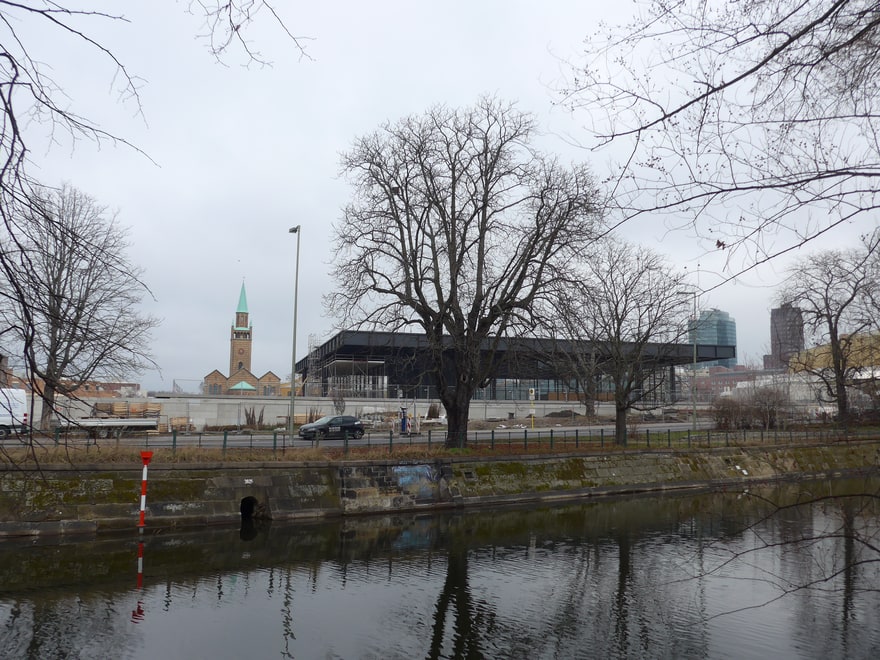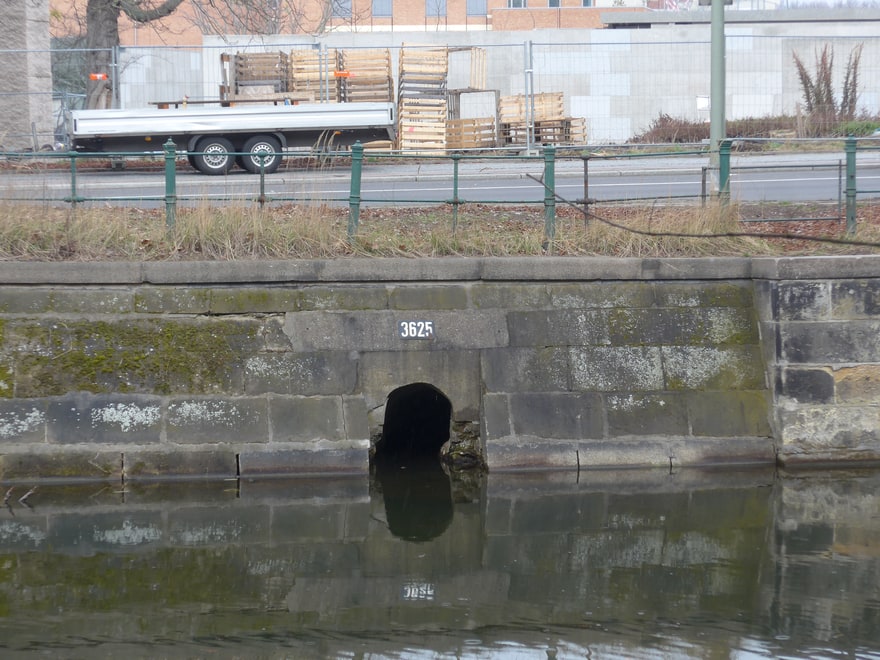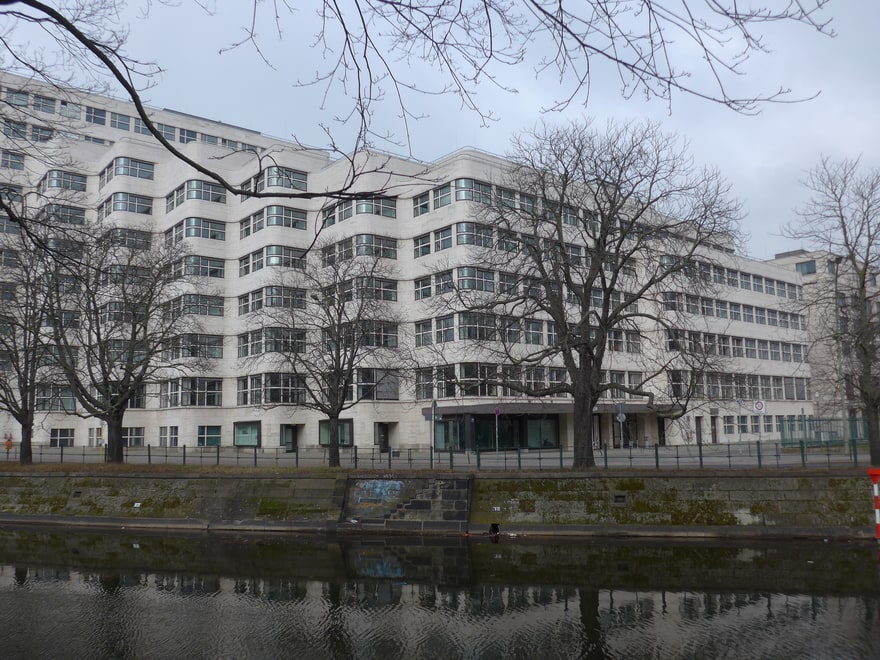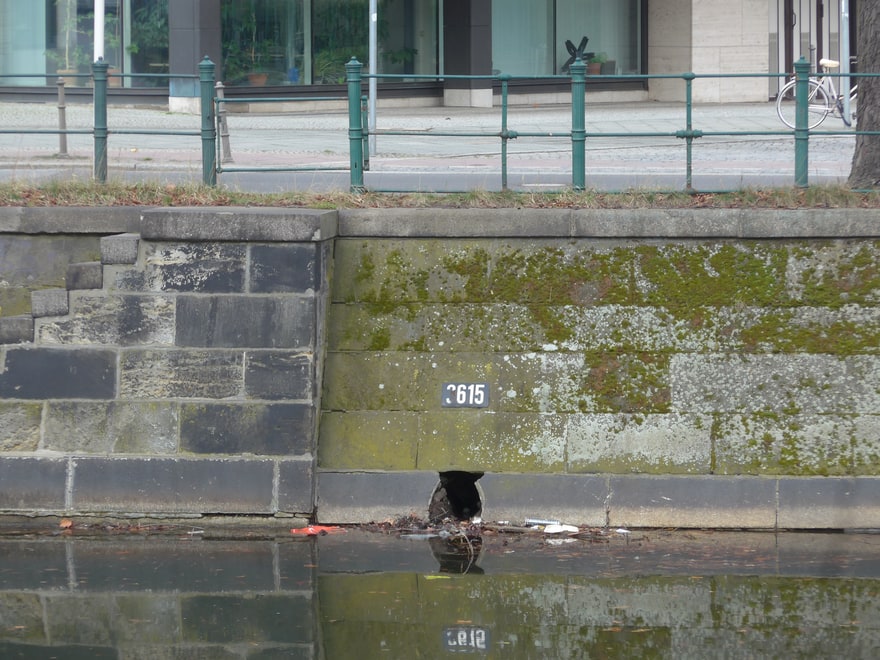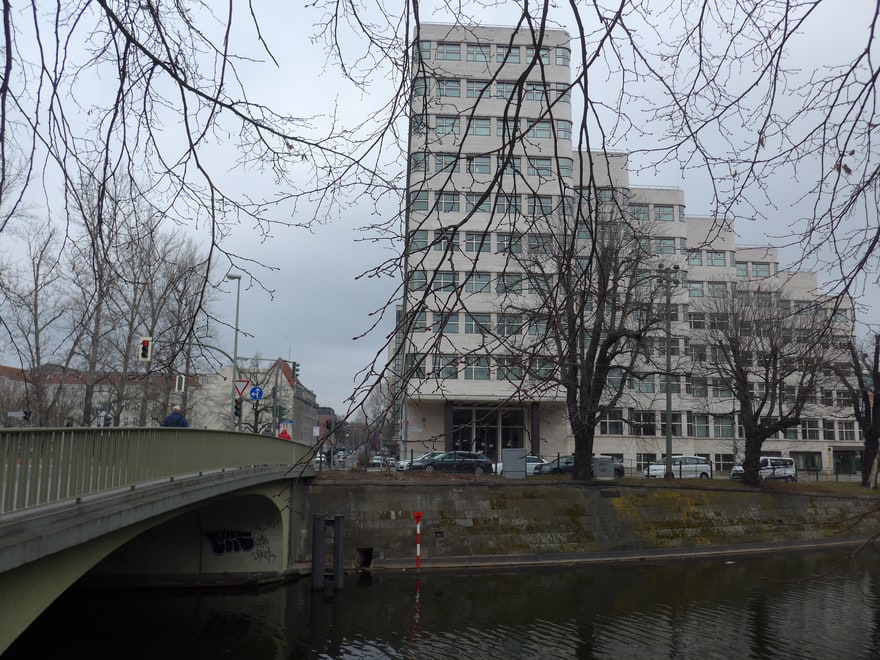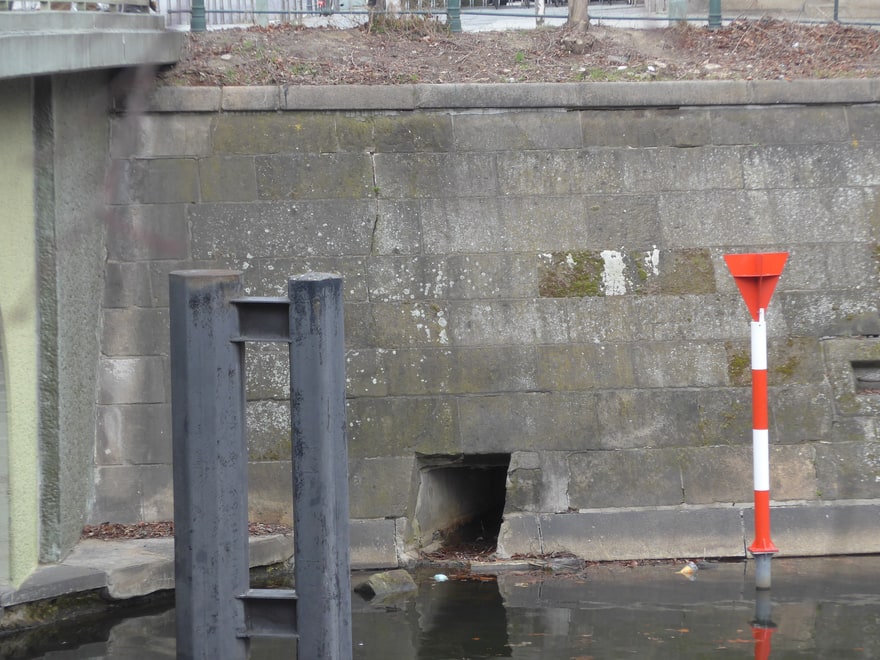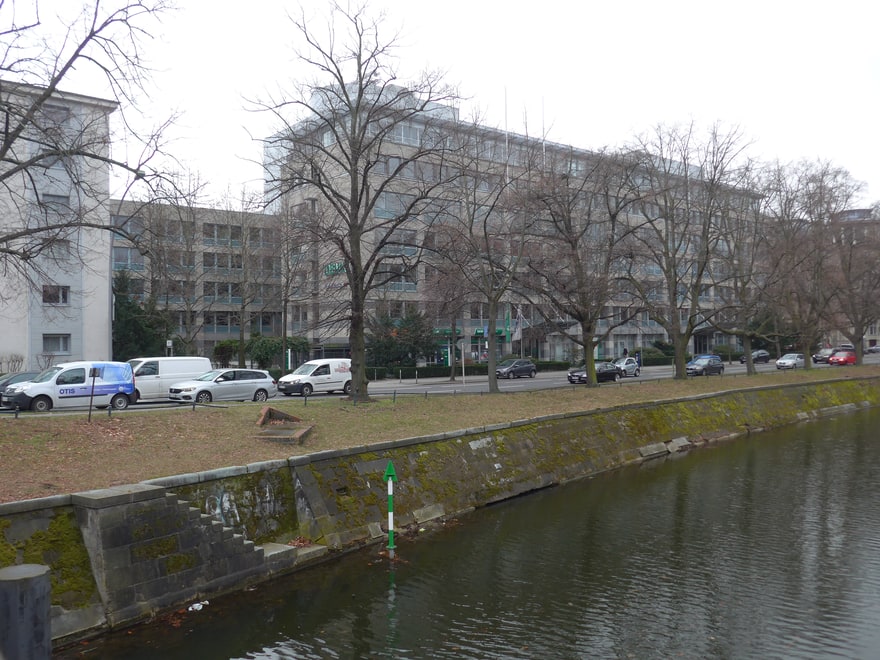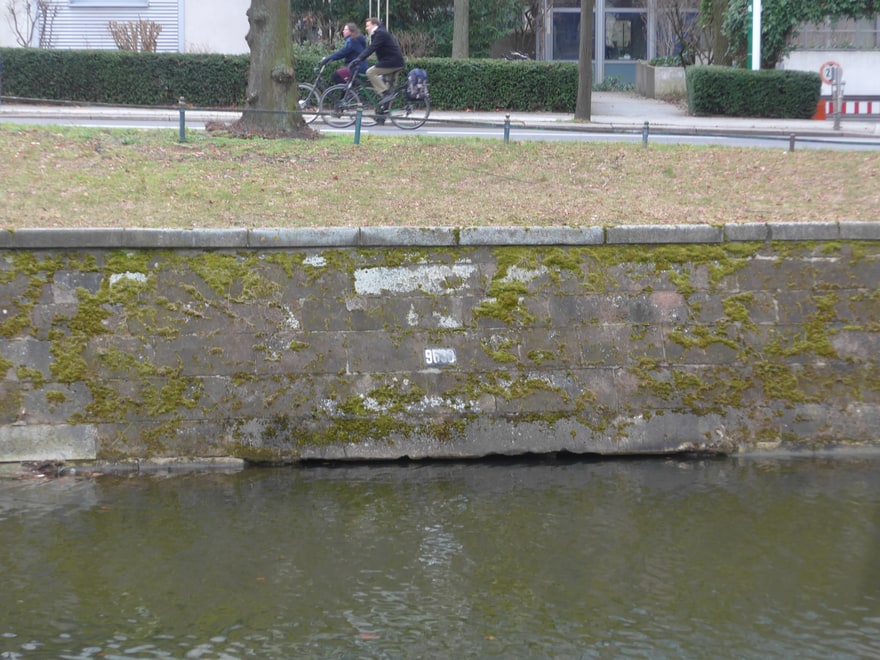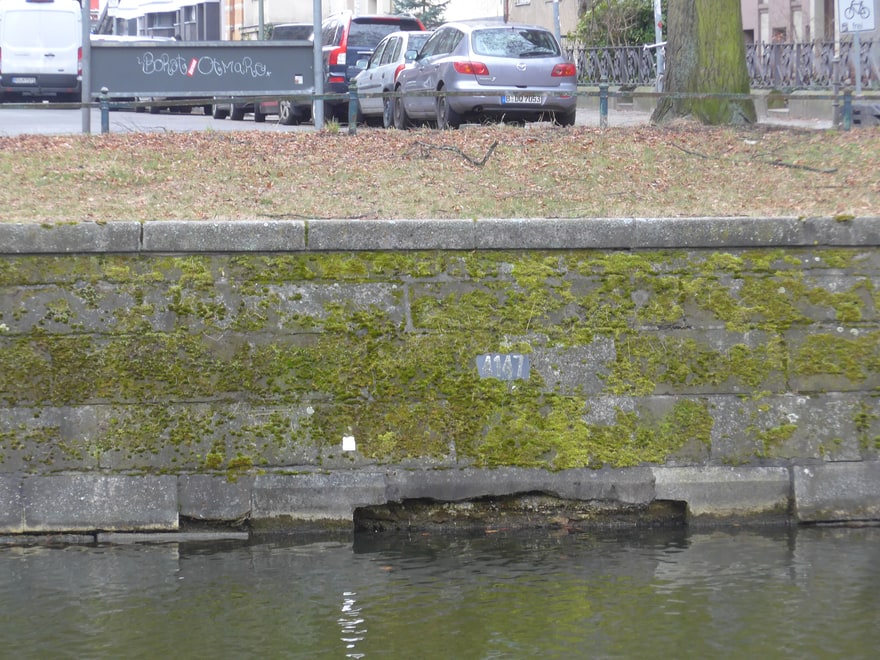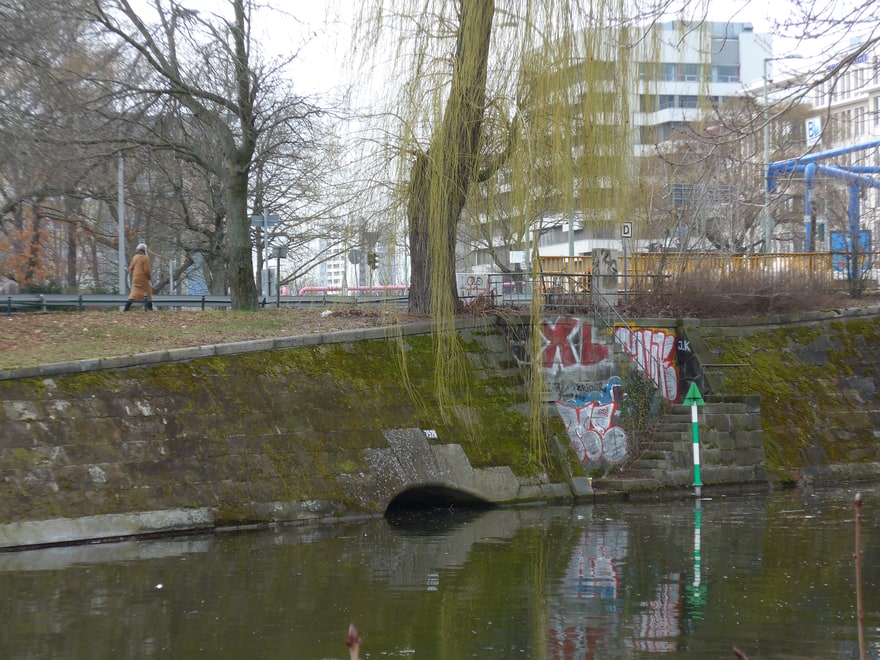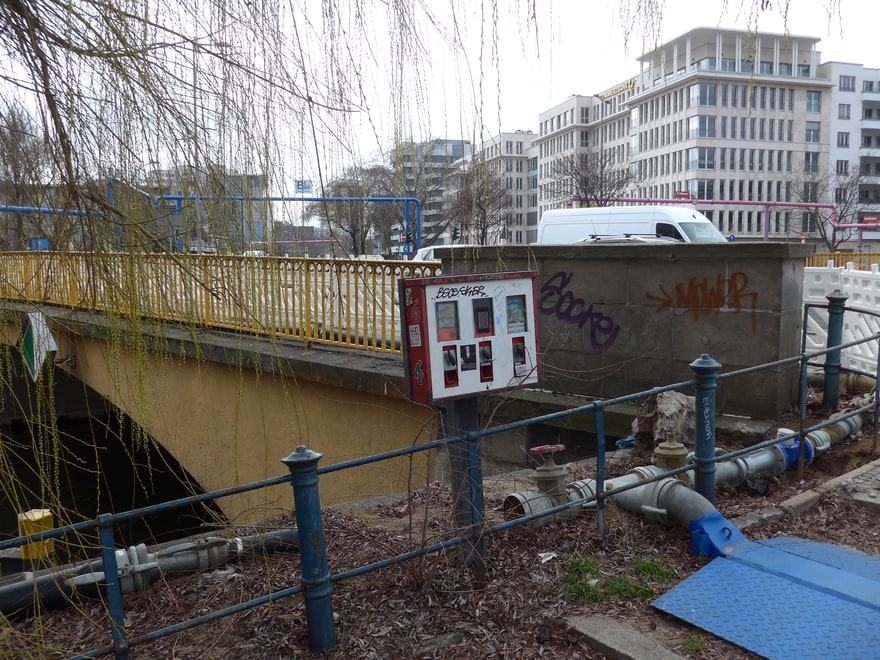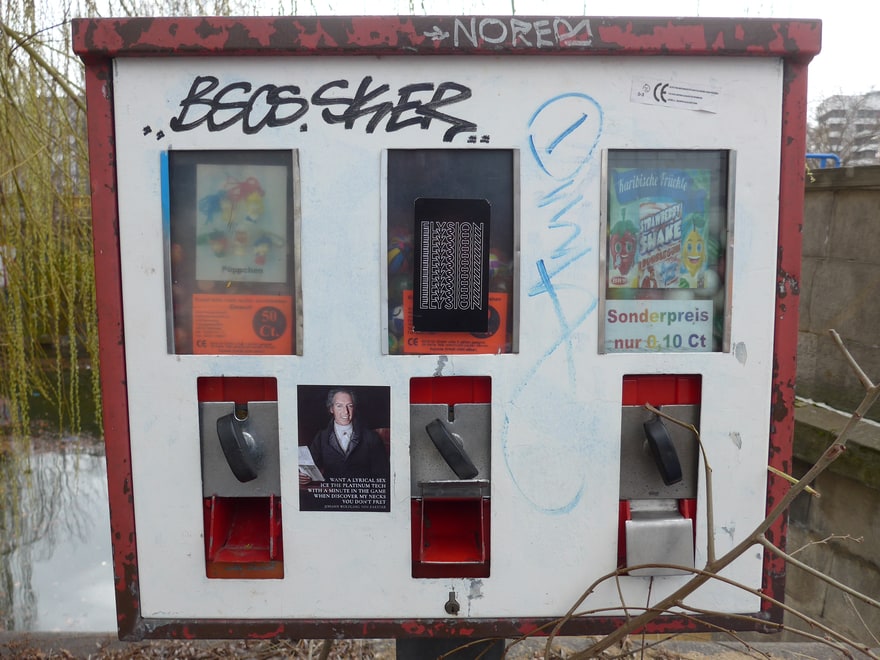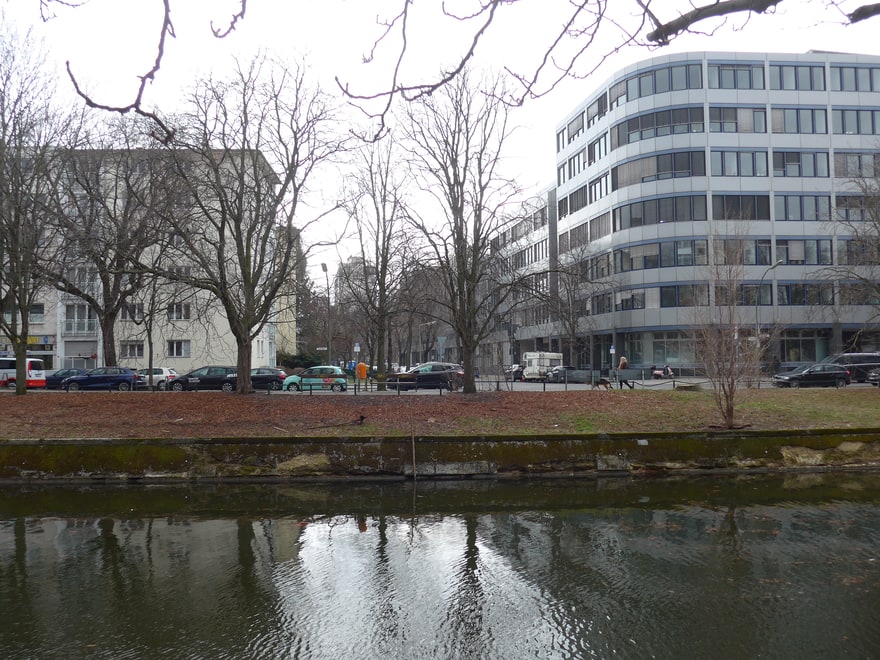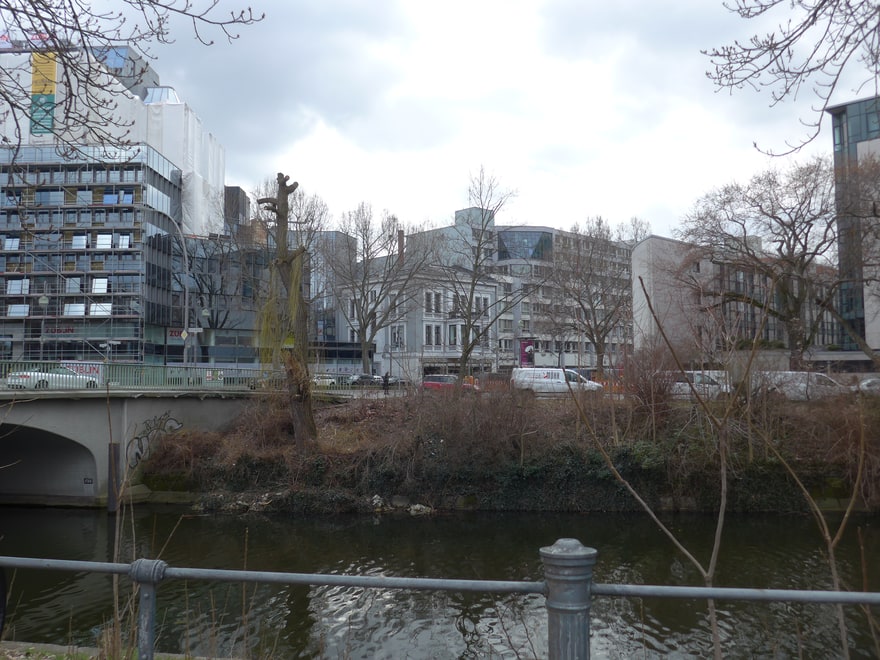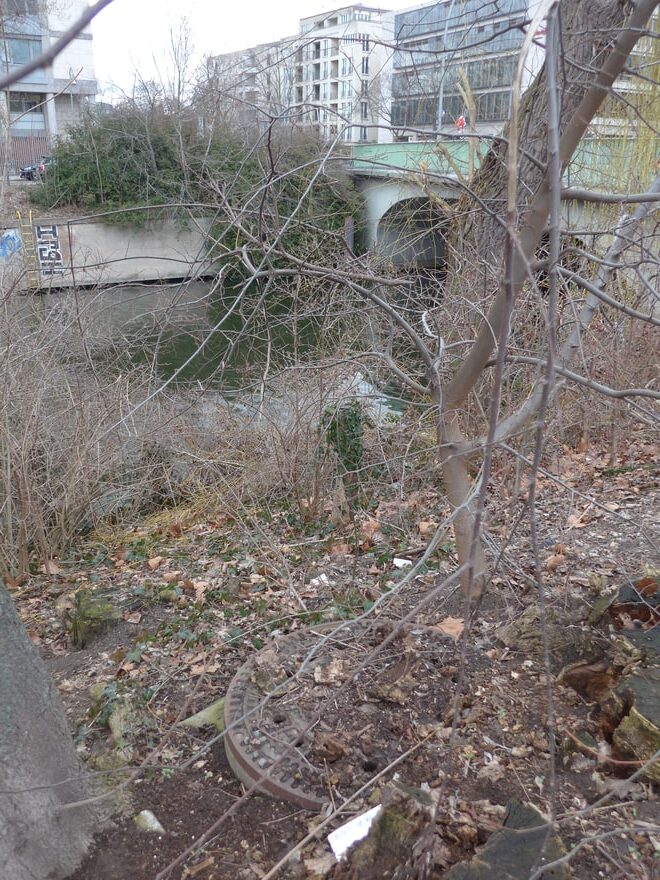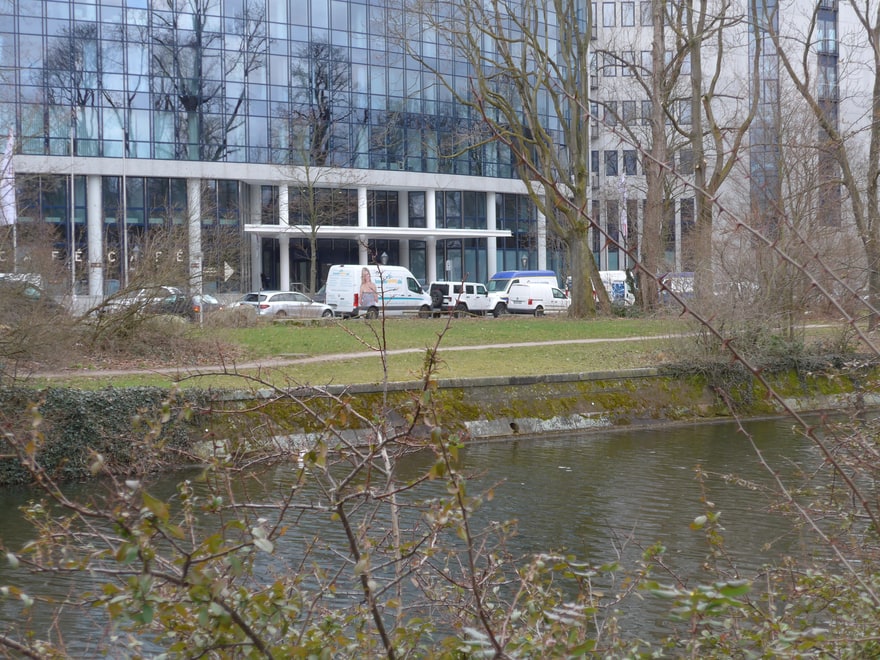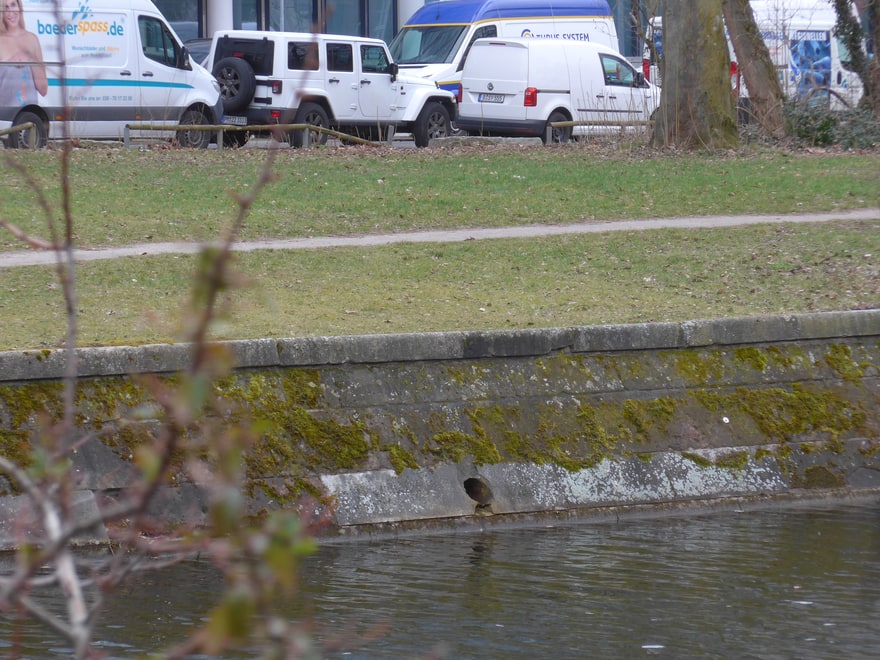Raw sewage flows into the waterways in Berlin and many other cities on a regular basis. Some are doing more about it than others.
When you flush a toilet anywhere in central Berlin during a moderate-to-heavy rainstorm, much of the waste goes directly into the Spree river that runs through the city, or into one of its several canals. This happens on 30 to 40 days each year, sometimes as many as 60. This post is a documentation of just a few of the 120-odd outlets where the untreated sewage enters the waterways.
Many cities around the world have, or had, the same problem, but they also have comprehensive strategies already underway for combating it that are costing into the billions, which Berlin does not. Hardly any of these cities are considered progressive on environmental issues (Washington D.C., Philadelphia, Milwaukee, New York, Cleveland to name just a few of hundreds) and none of them have a Green Party in power. Yet that is Berlin’s reputation and the Greens have been a major party in the city legislature for 40 years; currently they’re about tied for the most seats.
So what’s going on? The solutions were cutting-edge when first introduced thirty years ago (although based on systems understood for centuries) but now they’re arguably the status quo. It seems Berlin hasn’t gotten the memo. It’s hard to argue that a city that routinely pipes raw sewage into its waterways, and is behind its peers in addressing the problem, is as “green” as its image.
In some cities entire city departments and local nonprofit organizations are dedicated to informing the public about the situation and involving them in the solutions, with expenditures reaching into the millions – just for the public outreach, that is. Some have even built stormwater community education and research stations. By comparison, Berlin used to have one employee for water outreach but the position was eliminated in 2015.
To inform the public about the sewer outlets and whether they’re overflowing, water authorities have online interactive maps with real-time updates. Many have signs posted at each outlet in multiple languages, often with an ID number and phone number to call in case of malfunction. Scores of agencies and organizations have published hundreds of K-12 lesson plans and learning activities on the topic available for free download. None of these things exist in Berlin or elsewhere in Germany.

The releases of untreated sewage are known as combined sewer overflows (CSOs), and the reason they’re important is that the pollution from them persists over the whole year. The yearly overflows on Berlin’s largest canal alone contain enough sewage to fill its entire length twice over. The pollution is severe enough that not one of Berlin’s rivers or lakes meets the European Union’s legal standards for water quality and ecological condition, which they were all required to meet by 2015. Twenty-one years after the law’s enactment in 2000, the city still doesn’t have a compliance plan or an estimate of when, if ever, it will meet the requirements. As a result, the E.U. has taken the first steps towards lawsuits that can result in fines of hundreds of thousands of euros per day (which under E.U. law are filed against countries, not individual cities).
Visualizing sewage benefits everyone
Cleveland is one of numerous cities (Philadelphia, Seattle, New York for starters) that shows you where the CSOs are and if they’re overflowing right now…
…clicking on each CSO brings up detailed data…
… and a photo of the outlet.
Seattle posts signs at its CSO outfalls in five languages…
What Berlin does have this map in pdf format which is not available to the public. I found it on the “grey web” where it was leaked by an anonymous source and what you are seeing here is its first publication other than that. It’s a primitive and slapdash affair of limited usefulness. Not only is it not linked with data, like something dating from thirty of forty years ago, before the internet even existed, but even the numbering of the outlets has nothing to do with the numbers painted on the outlets themselves, as in the photos I took on-site (below). Not to mention the jagged seams between the sections.
Berlin is not the only city with a CSO problem. Most cities that were of any substantial size in the early 1900s have the same situation because that’s when their sewer lines were built, using a now-antiquated system. Smaller and newer towns usually have newer sewer systems that don’t have the probem. The closest Berlin comes to a plan to do something about it, however, is a proposal that’s been underway for 25 years to block off an arm of the Spree and line it with concrete to turn it into a swimming pool, which in a remarkable stroke of magical thinking is being billed as a water quality improvement project – a wildly popular environmental Theranos except the bubble hasn’t burst yet.)
By contrast, in New York, which is just three times the size of Berlin, 70 organizations participate in coalition dedicated entirely to stormwater and CSOs called Stormwater Infrastructure Matters, or SWIM (the name pre-dates Black Lives Matter by a decade or so). There are towns and counties a fraction of Berlin’s size such as New Haven and Milwaukee with whole organizations for citizen outreach and action on stormwater.
The bill for unbridled growth has arrived and it’s not cheap
Many cities have expensive programs to deal with the situation and fixed targets to reduce the overflows. New York is spending $6 billion, Honolulu $5bn, St. Louis $4.7bn, Cincinnati $3.3bn, Cleveland $3bn, Washington $2.6bn, Kansas City $2.4bn, Portland $1.4bn, Atlanta $1.1bn. Most of these cities are considerably smaller than Berlin.
Berlin is undertaking some measures and spending money on the problem but there is no plan with targets and budgets for reducing the CSOs. On the surface it may appear there is some of the green infrastructure that has been the industry standard elsewhere for twenty years now and is much cheaper and better for the climate than the older types of “grey” infrastructure (which New York, for one, has eliminated from their stormwater planning altogether).
But when you look closer, you discover green infrastructure for CSOs is only used on private property as a purely voluntary measure. There’s no actual targets for reductions of the amount of sewage overflows and the reductions aren’t even measured, so no one knows how effective any of this is. Berlin has no green infrastructure on public property and no plans to have any.
Politicians are not well informed on the issue. At a recent hearing of the Berlin legislature, the speaker for environment for a progressive party asked if we could just tear out the whole sewer system and replace it. When an alleged environmental expert in such an important role asks a question like that, in 2021, you have a serious problem. The city council should have cleared up this point thirty years ago, because no large city has ever has replaced their entire CSO system and never will. I estimate it would cost 50 to 100 billion dollars and take well over 100 years, given that it took Portland, which is fraction of Berlin’s size, thirty years and several billion dollars just to install retrofitted CSO control structures into the existing system.
The antiquated sewer system is called a combined system because it collects both stormwater from the streets and wastewater from kitchens, bathrooms and industry into one combined pipe system that leads to the treatment plants. The catch is that the system has overflow pipes that serve as safety valves when rainfall overloads the system. The overflow pipes carry the combined rainwater and raw sewage directly into the rivers and lakes. The consequences for water quality and the health of rivers, lakes and oceans are devastating.
Farmers could see where this was going
Combined sewers were acceptable 100 years ago, before there was much concern over water pollution. Further, the overflows are more common now than they were originally. One reason is that the rate of sealing over the land’s surface with pavement has grown continually for a century and shows few signs of slowing down. As a result, whenever it rains, more rainwater enters the system than it used to, instead of soaking into the soil.
Farmers could see this coming, if this highly sophisticated depiction of the situation from 1956 is anything to go by. The hydrological and ecological principles haven’t changed, and yet the pages are from a book not by an ecologiist or hydrologist but by a farmer and artist.
The other reason for the increased CSOs is that the climate crisis is increasing the intensity of rainstorms. This is why doing something about CSOs is an essential part of climate adaptation and resilience.
Separate sewer systems for wastewater and stormwater first appeared about 100 years ago, almost entirely in newly built districts and in exisiting parts of cities that had never had a sewer system to speak of. I’ve never heard of a case where a city replaced an existing combined sewer system with a separated one although this could have happened somewhere.
Separate sewer systems don’t have the problems with raw sewage because one set of pipes carries the wastewater to the treatment plants and another carries the stormwater to the waterways. However they are still a major and harmful source of pollution because the stormwater is untreated and carries pollutants from the air, roofs, walls, roads, cars, and excess fertilizer from lawns. This is known as non-point source pollution, to distinguish it from individual, concentrated “point” sources such as factories.

In the U.S., twelve percent of the population lives in the roughly 700 localities that have combined sewers. The E.P.A. has sued over 200 of them for water quality violations since the mid-1990s, resulting in the aforementioned expensive imporvements to the systems. The German government does not sue cities in this way.
What a sewage outfall actually looks like
What follows is a sample of Berlin’s CSO outlets. They may look unassuming but they are responsible for annual blooms of toxin-producing algae that each year kill pet dogs and make children seriously ill when they fail to follow the city’s spontaneous, short-term swimming bans. The CSOs also cause fish die-offs where thousands of dead fish float to the surface.
Digression. Next to #45 is one of the best things in Berlin. It’s a vending machine for little toys which looks as though it could have been there since the 1970s and would weigh 500 pounds. It’s hidden on a canal bank just off a heavily-trafficked street in a desolate and miserably ugly business district with no life, no shops, and no people (although it’s directly in the middle of the city). Incredibly, it works. In a notoriously broken-down city (ask any German about this) it almost feels like the vending machine is the only thing in Berlin in good working order that does what it’s supposed to do. I bought a super ball (20 cents) and a tiny doll (50 cents) with a suction cup on the back.
